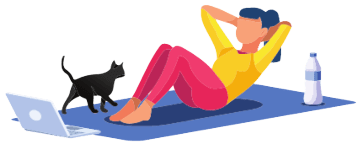In the last year, I went back to school. As a life-longer learner, I enjoy a challenge, and it’s through learning new things that we grow and change. Don’t you agree?
In my classroom at the school on the coast of Maine, my fellow students and I spend many hours on fascial manual therapy coursework designed to assess movement, instruct greater postural awareness, and refashion the soft tissue of the body. Once back in my studio in New Mexico, I use the methods, including a dose of corrective exercise, asking clients to integrate all into a home-based program. Over time and with hard work, challenging exercises help create growth and change for my clients, and the foundational importance of good alignment and posture becomes evident.

One of my teachers, Tom Myers, an author, and manual therapist, has been instrumental in bringing awareness of our fascial health to many health professionals in the last two decades. Myers says of posture “a posturally aligned body will degenerate more slowly than a body whose posture deviates.” Better posture better preserves us, equipping us for healthier aging. And regardless of your current age, if you are reading this article, you’re invested in aging well and with great vitality.
Speaking of posture, one of the most common deviations I see in my studio is a forward head. This position, or more accurately this postural dysfunction, can lead to neck pain and headaches. And, indirectly, forward head positioning can be affiliated with discomfort in the lumbar area and around the shoulder blades. Even balance can change over time if forward head and posture are not addressed.
In my practice, assessing posture is part of the first assessment for any fitness planning. With a client, I get permission to snap body images. Each image is taken from a different position—anterior, side, and back views. For example, an image taken from the side will quickly show how a client holds her head. To determine if my client is truly holding her head forward, I print the photo, draw-in a vertical line starting at the ankle bone and upward through to the top of her head. A picture is worth one thousand words. If the center of the ear isn’t tracking closely over her shoulder, this is often where we begin our work together.
Next, there are ways to test for the muscle strength of the neck. Most often the four deep neck flexor muscles are long and underactive. These four muscles are true to their name: they lie deep and close to the vertebral column at the neck. If long and underactive, these muscles are held in a stretched position – yes, a forward head stretches these muscles, and in this lengthened position they are, therefore, weak. Again, a muscle test of the deep flexors can help determine their relative weakness.

posture is important…
Once the test of muscle endurance is complete, my client and I work to set up a series of simple exercises using affordable equipment: a foam roller, a set of resistance bands, and a mirror. A mirror helps immensely with alignment and form! If there’s dedication to performing the exercises most days of the week for around three to four months, there’s remarkable improvement in posture, awareness, muscle strength and, maybe most importantly, greater ease of movement and less discomfort and pain. Over time, and with an ongoing home-practice, the soft tissue grows stronger and offers more support to the bones and alignment improves.

Is it time for you to create more awareness of your posture? Are there areas where you can change? Do you have discomfort or pain in your neck? Where is your head? Have someone take photographs to see if you have any deviations from a more aligned body. If you find your posture needs attention, the body will respond to a good movement practice. Better alignment will serve you well.
